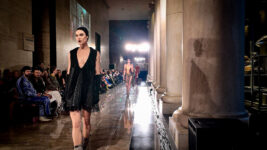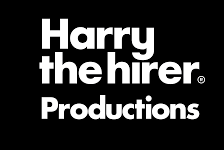News
1 Nov 2019
Holograms – A User’s Guide to Blowing Minds
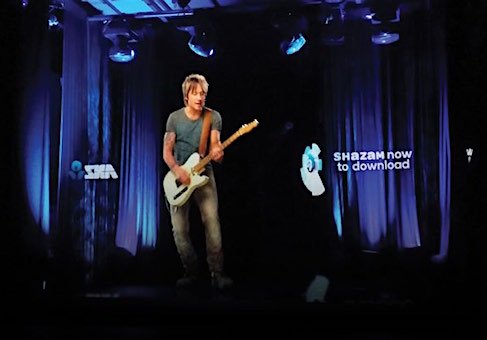
Subscribe to CX E-News
TECHNOLOGY
Holograms – A User’s Guide to Blowing Minds

From CX Magazine – August 2017
Whether you call it a ‘hologram’ or the ‘Pepper’s Ghost’ illusion, projecting video that looks three-dimensional on-stage is now part of the production repertoire. While the technique was first described in the 16th century and popularised in the 19th, we now associate it with high-tech implementations like Tupac’s posthumous performance at Coachella in 2012. With two competing toolkits on the market, we ask two leading Australian practitioners for their tips, tricks, and opinions on the state of the holographic art…
Haycom, the multi-city AV company that are now part of the NW Group, have been the exclusive Australian agents for London-based Musion for ten years.
Musion are largely responsible for the modern phenomenon of live holograms, with their Eyeliner foil and rigging system the solution of choice for the majority of globally-watched events that used the technique, from Coachella to the Grammys.
On paper, it’s simple – Eyeliner is a clear foil that is stretched at tension over a proprietary frame. This is rigged above a stage at a 45 degree angle. A reflective surface is placed on the stage, and a projector beams on to it. The projected image reflects into the foil, et voila, a hologram! Of course, it’s nowhere near that easy to get right.

Height, Width, Depth
“For a start, it doesn’t go up quickly,” said Mario Valenti, Director of Sales at NW Group. “Our crew need a minimum of six hours. Ideally, you want to do it in a venue that has height, width, and depth.

“It really works when it’s built into a set, which stops it looking ‘boxed in’. We’ve had great success with it at venues like The Hordern Pavilion and the old Pavilion at Randwick – ceiling height is really important.
“We’ve also used it from fly bars at the Sydney Theatre Company and at the Opera House. Tiered seating is a challenge, as you have to make sure the audience aren’t looking down onto the reflective surface on the stage.
“Having the audience spread 36 degrees either side of the illusion is optimal. When we’ve got a large audience and the angles are restrictive, we’ll increase the foil to 12 metres wide, which increases the viewing angle. The ideal audience size is 400 to 500.”
With the Eyeliner foil and the patented rigging, Haycom then need to provide their own projector, media server, and high-gain surface for the stage.
These can be anything suitable for the job, and Haycom chooses to use Christie 20K projectors with short throw lenses, Dataton’s Watchout for media, and front-projection screens from their regular stock. “With Musion, it’s important to have depth behind it,” continued Mario.
“You need space and lighting that creates the extra dimension of looking through and behind the image. Sometimes we get asked to do Musion in venues where it won’t work, and we have to say ‘no’ because it would look two-dimensional.
“When we do a six-wide and four-high Eyeliner screen, four metres high, at 45 degrees, with a 20×11 reflective surface, that gives us an optical height of 2.9 metres.”
Content is King
The Eyeliner foil is the most expensive part of any Musion gig – and it’s a one-shot deal per screen. After being tensioned, it’s disposed of.
“It is the big ticket item,” Mario pointed out. “It’s a clear acetate-type plastic surface that comes on a big roll. The rigging is part of the license and is patented. It’s an expensive product. It creates the ‘Wow!’ factor, but it’s not for everyone’s budget.”
Even more important though, is the video content.
“Never underestimate the importance of the content,” cautioned Mario. “We work with production company Shooting Star for content production. Every now and again a client thinks they can do the content themselves, but it’s usually a disaster.
“There’s all sorts of basics for hologram content that Shooting Star understand. For example, when filming a person on a green screen or black background, the lighting is really important – you need to create a silhouette around the subject for the illusion to work.
“The hardware’s great, but content is where it’s at. When you have both done well, the results are fantastic.”
Silver Machine
The emerging challenger to Musion is Holo-Gauze, a patent-pending fine polymer gauze coated in pure silver, developed by English multi-media artist and inventor Stuart Warren Hill. It’s a portable, easily rigged front-projection surface that’s rapidly gaining popularity.

The Gold Coasts’ IKONIX, a projection mapping, bespoke content, production, and set design firm helmed by Richard Saunders and Zachary Burton, is the first in Australia to have multiple Holo-Gauze surfaces for hire.
“The Holo-Gauze is hung flat off a pole or piece of truss with no angling and little tension,” explained Richard. “It takes 10 to 15 mins to set up. Projector wise, we won’t go lower than 14,000 lumens. Most shows we use one or two Christie 20Ks, depending on budget and room.
“We install the projector close and high, pointing at a 30 to 35 degree angle down at the screen. The projected image passes through the gauze and falls behind the stage so it can’t be seen by the audience. We position lights in a way to enhance the effect – we use a lot of profiles and beams to control directivity and spill.”
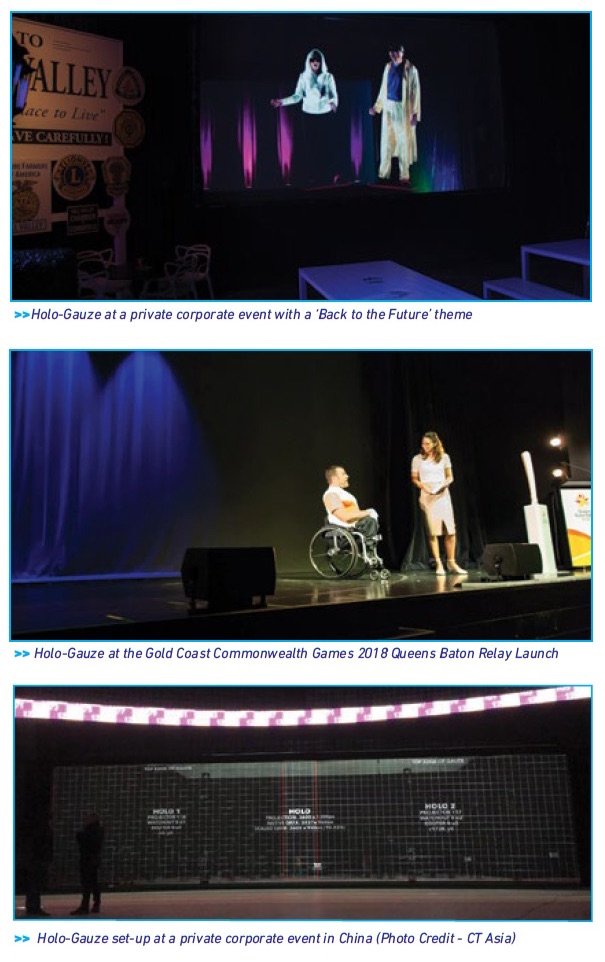
Go Deep
“If there’s any interactivity of performers with the video, we use side booms to light up the performers,” he continued, “or light from above depending on the venue. There’s a lot of hard shuttering to control the edges.
“For the best illusions, the bigger the gauze the better, which gives you a seamless image from left to right and top to bottom. A bit of backlight gives depth, and some people have been using LED walls at the back of the stage to give the illusion of depth – something going on behind the illusion makes it seem more real.”
Like Haycom’s Musion system, IKONIX provide their own projectors and media servers. “A pure black background in the content is key, so it’s all about the quality of the projector and its ability to project true black,” Richard elaborated.
“We only use Christie projectors, and I believe the majority of our competitors do the same. Media servers don’t have to be anything crazy; we use Avolite’s Ai and on occasion QLab. If we’re doing real-time interactivity with Kinect sensors, we might use Notch, Resolume, or d3.”
Kid Gloves
With recent notable Holo-Gauze outings including Eurovision, Beyonce at The Grammys and superstar DJ Eric Prydz’ ‘Epic’ tour, the product is rapidly gaining traction. “Its main point of difference is the brightness of the illusion,” observed Richard.
“It’s also the only surface that can produce true stereoscopic 3D with glasses. However, because it’s coated in pure silver, it’s very expensive. We handle it with cotton gloves because the acid on your fingers can tarnish silver, so it’s quite delicate.
“You can treat it like a gauze, but you have to maintain the etiquette of how you put it up. It travels in special bags and doesn’t leave our sight.”
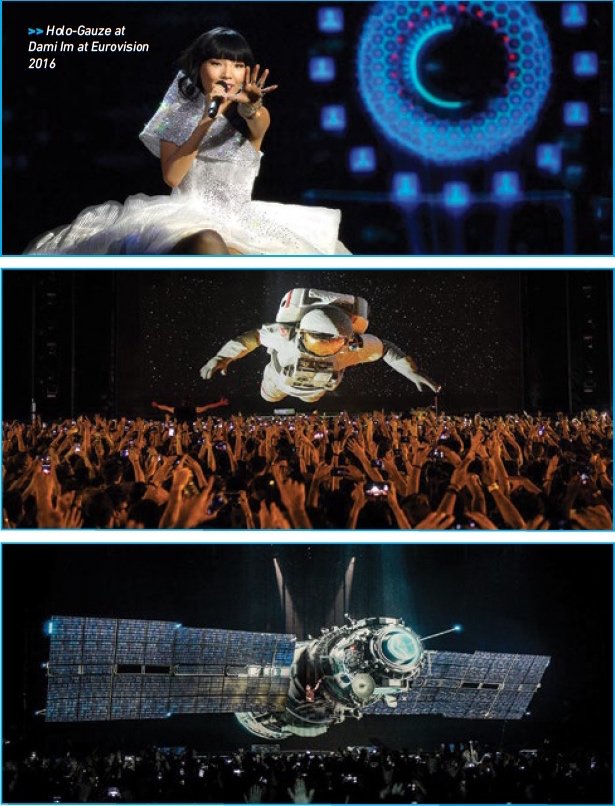
(Photo credit Antonio Pagano)
From CX Magazine – August 2017
View article as printed here (PDF – 650KB)
Lead image: Musion Keith Urban hologram (Photo credit Belle Laide Events)
Subscribe
Published monthly since 1991, our famous AV industry magazine is free for download or pay for print. Subscribers also receive CX News, our free weekly email with the latest industry news and jobs.



